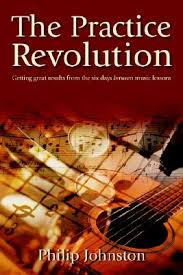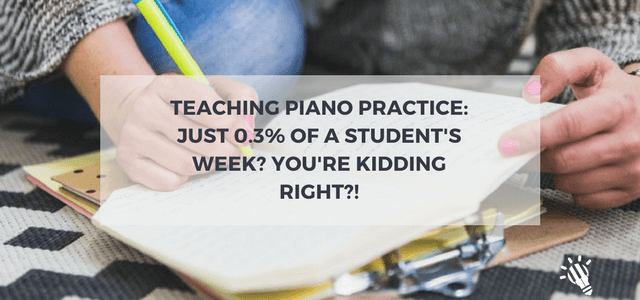Have you ever calculated just how little time you get to spend with your students out of their total working week? It’s a fascinating and insightful exercise and its result should dictate much of what we do with students during lessons.
Last year, I read a fantastic book called “The Practice Revolution” by Australian piano teacher Philip Johnston (a must-read for all instrumental teachers by the way). It has made me totally rethink my approach to teaching, setting goals, using a practice diary and what I actually do on a lesson by lesson basis.
Consider this: if you’re teaching 30 minute instrumental lessons, you are seeing a student for just 0.3% of a his/her available time in a week!
That’
Recently, I have come to realise that with my young and teen beginner and intermediate students, I seem to spend as much time teaching them how to practice as to how to play! Perhaps this isn’t surprising, but I have never really thought about it much until recently.
In my opinion, expecting kids, who struggle to even manage their own daily routine or remember what to bring to school, to magically be able to structure a concise and effective hour-long solo practice, is ridiculous!
We have to teach practice skills – both to students AND parents – as much as we teach playing skills!
The key for my students each week is achieving goals. I try not to recommend a set amount of time that they have to sit at the keyboard; rather, if they have achieved the goals I’ve set them by the next lesson, they have done the work. As long as you set achievable but challenging goals, time becomes somewhat irrelevant, clock-watching stops and parental nagging can subside (at least a bit!).
The best bit: if students follow my practice tips, they can reduce the time it takes to achieve their goals, streamlining their practice. Given that most kids are so time-poor these days and that music practice often comes off second-best to other after school activities, this is vital. Let’s face it, the goal for many students is to do as little practice as possible. More and more, this is a necessity.
So what are a few of the tips I use?
Let’s look at scales.
We all know the merits of practising scales and arpeggios, but we also know that if students practice their scales mindlessly and with deaf ears (as many do), they will need to spend ten times as long on them to achieve a set goal as they would have if they had focussed.
In order to do this, I suggest some of the following challenges which force the brain to focus:
There are obviously many more suggestions like these and they can be used in combination to be even more effective. The key is for students to realise that if they can text message and practice at the same time, they are not challenging themselves enough and will need at least twice as long to get something right.
Related: What I’ve learnt from asking more questions in music lessons
Students need techniques that force their brains to doing something harder than is necessary (like putting accents on different beats in scales) in order to reduce the time it takes for the brain and fingers to “get it”. It also ensures focus and concentration.
The other way I help students with their practice is to be very clear about what I write in their practice diary.
Not only will I set a goal (eg. “all highlighted sections of the Bach hands sep”), but I also set an at-home test so they know if they are ready for the next lesson (eg. “All highlighted sections of the Bach hands sep at 100 on the metronome, three times in a row, no errors”).
This test should be conducted a few days before the next lesson, so they have time to rectify any issues. In this way, students know how much practice they still need to do and gives them confidence that they will be ready for the next lesson.
These are just a couple of ideas for teaching students how to practice, and there are of course many more. What is important is that we don’t assume that students will be able to structure an effective practice session themselves. Some can, particularly as they get older, but many simply cannot. With just a few simple but clear suggestions in their diaries each week, you can make all the difference!
What are your top practice tips for students? How do you keep it interesting and keep them focussed?

Anne says:
Great article, thanks Tim! You’re quite right of course, our students need to be equipped with smart, effective & efficient practice strategies, and manageable goals (and mini goals!) I’ve been working on this with my students, over the years, and seen such a difference as I’ve implemented this approach. (Yay for Philip Johnston’s inspirational books – I’m a fan of his too 😊)
Keep up the good work inspiring teachers!
Sharon says:
When I assign scales or other technical exercises I try to always remind my students to choose 3 things:
1) What dynamic are they going to use? (how about a different dynamic in each hand?)
2) What tempo?
3) What articulation? (legato, staccato, etc. or a different one in each hand)
I had never thought to add different rhythms.
I know many teachers tell their students to not look at their hands, but I do encourage mine to watch their hands while playing technique warm-ups, because sometimes you think your hands are behaving and they are doing something totally weird.
Caroline Quinn says:
Thanks so much for posting this article. I am inspired to do the goal setting. I sent all the notes of the lesson each week by email to the parents. Having clear goals is a brilliant idea.
Keep shining brightly. It’s been wonderful to be part of your community. Such a gift!!!
Wishing you every joy and continued success!!!
Caroline Quinn
Miriam says:
I’m now re-thinking how to encourage practice, and welcome all your input: I was going to make a studio-wide competition where students set weekly practice goals (eg. 4 times/week, 20 mins each). Every week they reach their goal they get a sticker on a big chart. The top 3 at the end of the semester would get a prize.
How can I do this with the task -oriented goals? I wouldn’t want to penalize students if they really struggle with a passage one week and simply can’t reach it.
Any thoughts?
This is a timely post – just today I was going developing a competition to
Tim Topham says:
Good question. So the goal could change to number of pieces/bars/scales learnt, number of practice sessions recorded on an app (eg. practicia) number of performances uploaded to youtube. Try and think outside the box.
Work out what the goal is first (ie. what’s important to encourage the student to do), then work out the incentive scheme.
Philip’s book has LOTS more examples of competitions – amazing resource.
Amy Kendall says:
I often tell my students that they don’t have to sit down at the piano for 30 straight minutes for practice to be effective. I tell them even if they only have 2 or 3 minutes, they can accomplish “bite size pieces” of practicing. I highlight sections of music for them and tell them they can work on it between subjects of homework or even during commercials of TV shows. I think once they know in their mind that it’s a small goal for a short time, they are more likely to do it.
Tim Topham says:
How do you find your students’ ability to actually work on the small sections? No matter how much I coach kids about practising in small blocks (which I also mark on their music), so often they’ll just start at the beginning or so something equally as ineffective. So frustrating!
Amy Kendall says:
It usually takes me telling them repeatedly to work on sections, but eventually it sinks in. We work on sections in the lesson and I highlight each section I want them to work on with a different color highlighter tape. Then right next to it I write “Practice 5x every day” or something like that. They usually do it if I write it on the music!
Anita E Kohli says:
I totally agree with you. I spend a lot of class time teaching students how to practise. With beginners, I also find that the parents need help and ideas on getting their kids to practise – and with getting it done without discord, cos kids do give trouble to practise daily, until they get used to it.
Often it’s necessary to talk to parents about scheduling daily study at home, as well as play time, and helping parents see the educational value of this daily effort.
Most of my students practise because their Mum’s make it happen, by being around and listening to them, and making sure they read their homework book….I think, very often, that the ‘Piano Mom’ needs an award for her daily effort to help her child learn.
Tim Topham says:
Yes, the parents’ role is critical at a young age (and even for teens). I’m often surprised at how much I need to coach parents to realise that they have to make time for practice for their children. It’s just not obvious, so I think you’re doing all the right things getting them involved – great job!
The Dynamic Studio – brilliant new book from Philip Johnston | Tim Topham says:
[…] previously blogged about his other books including The Practice Revolution and Scales Bootcamp. The Dynamic Studio continues in his light-hearted, user-friendly and […]
Pittsburgh Traithlon Coach says:
TIm, by any chance do you swim? We use many of the same principals you write about here in teaching Total Immersion Swimming. Here is a blog post by Terry Laughlin that discusses how a “nimble brain” facilitates learning. I”m the quotee in the intro paragraph. That memory was jogged by some of Terry’s writings which I think you may enjoy. – Suzanne
http://www.swimwellblog.com/archives/1481
timtopham says:
Thanks Suzanne – I’ve been reading a number of articles on Terry’s blog today. All very interesting and great to see how similar high achievement is in any category – be it swimming or music, it just takes hard work! I have been a swimmer and triathlete in the past so your blog was also fascinating. Do you still play?
GUEST POST: FLOW: Transforming your Practice! « The Cross-Eyed Pianist says:
[…] recommended in this regard. My post about how my teaching has changed as a result of this book is here – please read it for more detail on this vital aspect of […]
timtopham says:
Just read this on another website:
“In the end, you teach yourself how to play the piano, with some help from others.”
When you think about the 0.3% factor, this is clearer than ever!